IT Consulting | IT Support | Managed Services | New Jersey Computer Support Services
Surveillance Camera Technologies

We Offer:
- Indoor/Outdoor cameras
- Vandal Proof Cameras
- Night Vision Cameras
- Pan/Tilt/Zoom Cameras
- Bullet, Box & Dome Cameras
 IP Camera Network IP Camera Network |
 Request a Quote Request a Quote |
 Point of Sales Surveillance Point of Sales Surveillance |
 Smart Video Surveillance Smart Video Surveillance |
Indoor Cameras:
Indoor cameras come in all types, sizes and styles. The most popular is the smoked mini dome camera. The dome camera can be mounted on the ceiling or wall and adjusted to view any angle. Although the dome is designed to protect the camera inside, they are not weather tight and should not be installed where they are exposed to moisture or extreme temperatures.
 Indoor Dome |
 Box Camera |
 Vandal Proof |
 Night Vision |
 Bullet |
Outdoor Cameras:
The only difference between indoor and outdoor cameras is that the outdoor cameras are in an environmentally protected housing. Some housings have heaters and blowers to keep the temperature inside within the operating parameters of the camera. Others such as the mini outdoor bullet cameras generate their own heat for operation. All outdoor cameras discussed in this guide are designed to operate in -10 degrees to 120 degree temperature.
 |
 |
 |
 |
Day/Night or Night Vision:
Affordable night vision cameras are the latest innovation to the video surveillance industry. There are many types and styles to choose from but they all have one thing in common, infrared LED's. Small LED's that transmit out infrared light surround the cameras lens. The LED's cast out light the camera can see but the human eye cannot. The distance a camera can see in the dark is based on how many LED's the camera has. As a rule a camera with 10-20 LED's can see 20 feet in complete darkness. Some cameras such as the one below can see up to 70' in complete darkness. Notice the LED's surrounding the camera lens.
 Indoor or Outdoor Day/Night Camera |
 70' Long Range Outdoor Day/Night Camera |
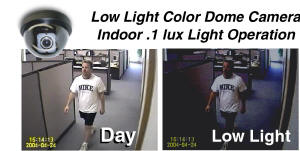 |
 |
Low Light Cameras:
Low light cameras are color cameras which need very little light to operate (.1 lux). They work well in most applications but they do require some lighting, similar to the lighting provided in a romantic restaurant.
 |
Hidden Cameras:
Because cameras are so small now they can be hidden in almost anything. It's common to see cameras in pictures, clocks, radios, smoke detectors, motion detectors, books, ties and anything else we can dream up. The cameras are the same cameras used with standard indoor cameras. The only difference is the housings used.
 |
 |
 |
Pan Tilt Zoom Cameras:
PTZ cameras, as they are called, are considered "top of the line" in security cameras. They can pan 360 degrees, tilt 270 degrees, and optically zoom in as much as 22 times. They are controlled and programmed with either a desk top joy stick control or through the software of a PC based DVR. They come in both indoor and outdoor versions, can be wall or ceiling mounted, and can be equipped with color Day/Night cameras or night vision.
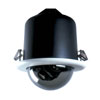 Indoor Recessed PTZ |
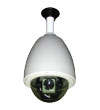 Ceiling Mount PTZ |
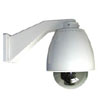 Wall Mount PTZ |
The cameras can be programmed to automatically run preprogrammed tours, automatically panning, tilting and zooming to predetermined locations. They can also be programmed to pan, tilt and zoom to a specific view if motion is detected or a pre-defined alarm occurs. A user can override the automatic operation and control the cameras as needed. Up to 16 PTZ cameras can be installed on most DVR systems (as long as the DVR supports 16 cameras). The cameras are controlled with a two wire communication wire which loops from one camera to another. Each camera has dip switches which are used to set its address. The comm. wire can have a maximum distance of 3000 feet. In addition to the communication wire each camera also required a video cable to transmit the video signal back to the front end.
Camera Specification Guide:
Below you will find operating details on the various aspects of security cameras. If it seems confusing simply refer to the camera flow charts listed below. All the cameras listed meet and exceed the minimum standards for professional surveillance applications. A lot of this information is good to review but you really do not need to memorize it.
Lines of Resolution:
Each cameras performance is based on the number of horizontal lines the chip in the camera provides. The lines of resolution dictate the quality of the video the camera can produce. The higher the lines of resolution, the better the quality.
| Performance | Color | Black and White |
|---|---|---|
| Standard | 330 Lines | 380 Lines |
| Medium | 420 Lines | 470 Lines |
| High | 480 Lines | 580 Lines |
Lens:
The lens dictates the field of view the camera provides. Lenses range from 2.8mm to 18mm on an average. The larger the lens size the farther it will view. The draw back to a 12mm or 18mm lens is that the horizontal view narrows to as little as 15'.
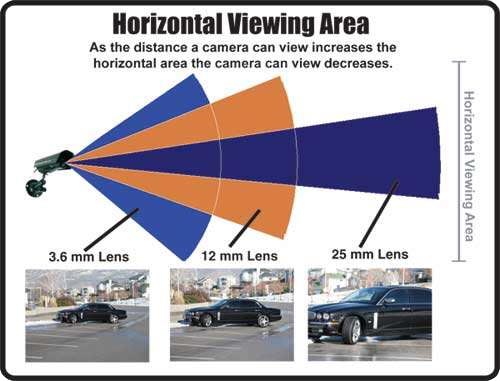 |
Distance Charts:
The lens dictates the field of view the camera provides. Lenses range from 2.8mm to 18mm on an average. The larger the lens size the farther it will view. The draw back to a 12mm or 18mm lens is that the horizontal view narrows to as little as 15'.
 |
**As a general rule we recommend standardizing your cameras 3.6mm lens. They are designed to be installed in a corner, provide a 90 degree field of view, and provide effective surveillance in a 30' x 30' area. The number one mistake when designing a camera system is that we all expect one camera to do the work of two or three. Bottom line is, unless you pay the big bucks for a Pan, Tilt, Zoom camera, don't expect a camera to effectively cover more than a 30-50 foot area.
Auto Iris:
Almost all cameras have either a digital or mechanical auto iris. Most cameras have them built in. Do not consider a camera without auto iris. You will constantly be adjusting the camera as the light levels change.
LUX or Minimum Light:
When choosing your cameras pay attention to the amount of light which will be available in the areas you want to see. Most color cameras have a .1 lux minimum which means not a lot, but some light is needed for operation. You can tell if a color camera does not have enough light to operate because the picture will go grainy. If you are not sure you have enough light consider using night vision or black and white cameras. Black and white cameras have a .01 lux minimum and do much better in low light. Night vision cameras can see in complete darkness or 0.0 lux.
Power:
Cameras are powered with either 12V DC or 24V AC power. It does not matter which you choose as long as you don't connect a 12V camera into a 24V power supply or 24V camera into a 12V power supply. We recommend using 12V DC cameras and power supplies.
Viewing Angles:
Below are samples of the "fields of view" which the most common lenses provide.
 |
 |
 |
 |
 |
 |
 |
-
Download our brochure to learn more about us
Download our company overview for more information about us
Download Brochure
We Offer:
- Microsoft Silver Certified Partner
- Dynamic Support | Managed IT
- Cloud Computing for Business





